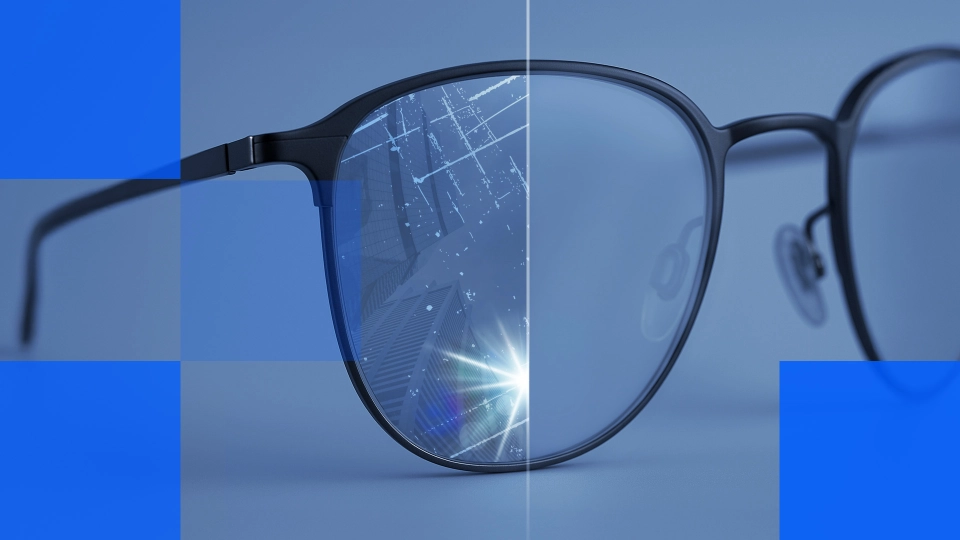
Lens Errors in Optical Labs: How to Identify & Prevent Costly Mistakes
- Common lens errors
- 1. Optical aberrations
- On-axis aberrations
- Off-axis aberrations
- 2. Prescription errors
- 3. Manufacturing defects
- Surfacing errors
- Coating issues
- Other physical defects
- How to reduce lens errors in an optical lab
- Pre-production verification
- In-process quality control
- Final quality verification
- Measurement tools for detecting errors
- How to solve and prevent lens errors in your optical lab
- 1. Staff training and development
- 2. Equipment maintenance & calibration
- 3. Process optimization
- Solving lens errors when they occur
- Why choose IOT for lens design and manufacturing support

Lens Errors in Optical Labs: How to Identify & Prevent Costly Mistakes
Lens errors are more than just quality control issues. They represent potential profit loss through remakes, customer dissatisfaction, and reputational damage. Modern free-form surfacing can get amazing optics out of ever-thinner materials, but the manufacturing window has also grown tighter. For optical laboratories, the pressure for error-free services requires maintaining high standards, operational efficiency, and a detailed knowledge of the most prevalent lens errors.
Common lens errors
Lens errors are the optical, geometric, or cosmetic discrepancies between the prescribed lens and the one that comes out of the lab. These deviations can appear at any production step and, if left undetected, degrade visual clarity, wearer comfort, and your bottom line. Common lens errors include:

1. Optical aberrations
Optical aberrations are deviations from perfect image formation that affect visual clarity and comfort. These can be categorized as on-axis and off-axis errors, though all of them come from small departures between the ideal and the real wavefront as it travels through the lens:
On-axis aberrations
These occur along the optical axis and include:
- Spherical aberration: Light rays passing through different zones of the lens focus at different points
- Longitudinal chromatic aberration: Different wavelengths of light focus at different points, creating color fringing and a reduction in sharpness, especially in high-power prescriptions. Though good to know, this is less common than off-axis chromatic aberration, so patients complain less frequently about longitudinal chromatic aberration.
Off-axis aberrations
These occur away from the optical center:
- Transverse chromatic aberration: Patients will see color fringing at the edges of objects as the colors don’t line up side-by-side. This is much more commonly reported and noticeable to wearers than longitudinal chromatic aberration, especially in polycarbonate lenses and lenses that are not properly centered in the frame.
- Coma: Off-axis point sources appear comet-shaped rather than circular
- Astigmatism: Images appear stretched in certain directions
- Field curvature: The focus surface is curved rather than flat
- Distortion: Straight lines appear curved (barrel or pincushion distortion)
These aberrations often occur due to:
- Algorithm errors in lens design software
- Incorrect lens material selection for the design
- Improper calibration of surfacing equipment
- The optical center isn’t aligned with the wearer’s pupil
- The optical axis of the lens is not aligned with the visual axis
- Choosing materials with poor off-axis performance
2. Prescription errors
A prescription error happens when the optical values manufactured into a lens deviate from the refraction written by the prescriber, even though the surfacing and coating steps may be mechanically perfect.
A pervasive point of confusion in free-form manufacturing surrounds compensated powers. Freeform lenses should be checked against the compensated power(referred to as the verification power in ISO standards) rather than the prescribed power. This value accounts for the patient’s position-of-wear parameters, so checking only against the original written prescription can lead to the false conclusion that the lens is “wrong.”
Power errors often are:
- Incorrect sphere power: The dioptric power of the lens doesn't match the prescribed value
- Wrong cylinder power: Astigmatism correction is inaccurate
- Axis misalignment: The cylinder axis doesn't match the prescription, causing induced astigmatism
- Add power inaccuracies: Incorrect near-vision power in progressive or bifocal lenses
- Unintended prism: Prism present in the lens that was not prescribed, typically introduced by equipment misalignment or calibration errors during surfacing.
These errors typically stem from:
- Transcription mistakes during order entry
- Misreading handwritten prescriptions
- Software errors in digital lens production
- Operator error in lens measurement verification, especially when failing to check against compensated powers in freeform lenses
3. Manufacturing defects
Manufacturing defects are physical flaws introduced during lens production on the lab floor. Unlike prescription errors, which stem from incorrect data, these defects may result from deviations in the process (regarding variables such as temperature, tool calibrations, etc.). They typically arise during precision-dependent steps such as coating and surfacing, where even minor deviations can compromise optical performance and durability.
Manufacturing defects can be grouped into three categories:
Surfacing errors
Surfacing is the process of shaping a semifinished blank into the final prescription lens. Errors at this stage directly impact accuracy, geometry, and wearer vision.
Examples include:
- Blocking: base curve deviation or warping, unintended prism, or thickness errors due to faulty blocking rings or miscalibration
- Generating: axis misalignment, central dots, incorrect thickness, or prism from poor tool adjustment or unstable temperatures
- Polishing: under- or over-polishing, scratches from slurry contamination, or incomplete polish
- Engraving: displaced or weak engravings that complicate verification
- Deblocking/handling: cracked or warped lenses from poor automation setup or thermal stress
Because each substep builds on the previous one, tight process control, precise calibration, and strict cleanliness are critical to prevent compounding errors.
Coating issues
A coating defect is any imperfection in the multilayer film applied to a lens—whether anti-reflective, hard coat, mirror, hydrophobic, or tint. These flaws reduce clarity, uniformity, or durability.
Examples include:
- Uneven anti-reflective coating (rainbow patterns or blotches)
- Newton’s rings from hardcoat/lens refraction index mismatch
- Residual AR causing color variation between batches
- Coating adhesion failures (peeling, crazing, cracking)
- Inconsistent tint application, especially in photochromics
- Hard coat irregularities that weaken scratch resistance
- Pits or visible dots in the hard coat layer
Common causes of coating issues include improper lens surface prep, contamination in AR chambers, poor DI water quality, incorrect curing times/temperatures, or ineffective cleaning and vacuum routines.
Other physical defects
Not every defect fits neatly into surfacing or coating. Factors such as handling, environmental conditions, or equipment inconsistencies can introduce flaws that affect lens fit, finish, or durability. While less common, these issues underscore the importance of stable operating conditions, ongoing equipment calibration, and careful handling at every stage of production.
How to reduce lens errors in an optical lab
Early detection is critical to preventing flawed lenses from reaching customers. Implement these identification strategies at key production stages:
Pre-production verification
- Material compatibility assessment: Verify that selected materials can achieve the required parameters and are appropriate for the intended frame type (e.g., rimless designs). When necessary, consult with the ECP if the chosen material could compromise durability.
- Consistent maintenance: Regularly service machines and monitor environmental conditions in the production room to ensure stability and repeatability.
- Inventory quality control: Check that semi-finished stock is stored properly and free from damage, and perform batch inspections to detect issues early.
In-process quality control
- Automated inspection systems: Use software and digital tools to maintain accuracy at every production step. This can include quality assurance software, digital surface mapping, and tracking which machines a lens passes through. Logging this history helps labs identify where defects originate and address root causes more quickly.
- Manual inspection checkpoints: Conduct visual inspections after each major step for extra control. An experienced technician can also provide a secondary review of complex prescriptions to catch subtle issues that automation may miss.
Final quality verification
- Full prescription verification: Using calibrated lensmeters/focimeters
- Mapping lenses: Confirming proper surface placement and power distribution, ensuring that the lens the customer will obtain is the one they want
- Cosmetic inspection: Under multiple lighting conditions.
- Physical parameter verification: Thickness and diameter
Implementing a structured identification process with multiple checkpoints helps labs catch errors early, when they are easiest to resolve. The sooner a problem is detected, the faster the root cause can be identified and corrected. With the right tools and workflows, labs can reduce remakes and errors without adding unnecessary burden to the production team.
Measurement tools for detecting errors
Labs can employ measurement tools and tests to help flag small deviations, such as optical power or surface form, before they leave the bench.
- Lensometer/Focimeter: Used to verify optical parameters such as sphere, cylinder, axis, prism, and add power in progressive lenses. Digital models improve speed and accuracy compared to manual focimeters and often integrate with lab management systems for streamlined data capture.
- Surface mapping: Measures lens curvature and form accuracy, providing a detailed view of surface deviations that may not be visible with standard lensometry. Modern systems can also generate detailed power maps, and compare the theoretical surface with the actual surface, highlighting any differences.
- Physical inspection tools: Traditionally, calipers and thickness gauges were used to measure center and edge thickness, bevel size, and cut accuracy. Today, many of these tasks are automated with digital measurement systems and machine-vision inspection. For example, automated thickness gauges or frame-fit scanners can check bevel alignment and edge quality, while rimless-drill inspection systems ensure durability and consistency without relying on manual checks.
-
Cosmetic inspection tools: Visual or automated checks that identify scratches, coating gaps, or edge-related defects. These inspections can detect incomplete AR treatments, missing coverage near edges, or visible lines that affect lens appearance and durability.
How to solve and prevent lens errors in your optical lab
Labs that routinely keep low remake rates excel in four areas: skilled people, reliable machines, friction-free workflows, and real-time data. Excellence in the following areas will help an optical lab prevent errors and remakes:

1. Staff training and development
- Comprehensive onboarding: New technicians shadow veteran operators and practice on scrap lenses until they can spot and correct common errors.
- Continuous education: Consistent training on new materials, new machines and processes, changes in auxiliary materials, and coating chemistries keep techniques current.
- Periodic quality reviews: Structured sessions to analyze recent defects, adapt standard operating procedures (SOPs) to new conditions, and identify long-term solutions to recurring issues.
- Certification paths: Support staff in pursuing relevant standards-based training, such as ISO or ANSI certifications for ophthalmic optics, to validate skills and improve retention.
2. Equipment maintenance & calibration
- Consistent critical checks: Follow manufacturer intervals for key equipment such as generators, vacuum pumps, coating systems, chemical concentrations, and temperatures. These preventative maintenance checks are fundamental for reliable and consistent performance.
- Usage-based tool replacement: Retire cutting tools, polishing pads, polish slurry, and others based on cycle counts, rather than waiting for failure.
- Environmental control: Maintain stable temperature (~20 °C / 68 °F) and humidity (<40%) in the lab, especially in the clean room when coating to minimize dust-related defects.
3. Process optimization
Consistent problem analysis and updates to Standard Operating Procedures (SOPs) help labs continuously improve and maintain reliable, efficient workflows. Some key practices include:
- Standardized digital tickets: Barcode or RFID tags on every tray ensure prescription data flows directly from the LMS/EHR to machines (blocker, generator, polisher, edger, etc.) without manual re-keying or sign flips. This reduces transcription errors and speeds up throughput.
- Critical-control checkpoints: Place quality-control gates after key steps (surfacing, tinting, coating, edging) so deviations are detected while rework is still possible and inexpensive. For example, checking prism and axis alignment right after surfacing prevents costly downstream remakes.
- “Mistake-proofing” fixtures: Use asymmetric block pieces, keyed tray slots, and other poka-yoke style controls that physically prevent operators from loading lenses incorrectly.
- Data-driven improvement: Effective process optimization depends on managing and analyzing production data. Many labs use statistical process control (SPC) tools like IOT Process Quality Control to monitor error rates, identify trends, and evaluate whether process changes are actually delivering improvements.
Bringing it together: The combination of structured SOP updates, reliable control points, physical mistake-proofing, and meaningful data analysis gives labs a closed-loop system for continuous improvement.
Solving lens errors when they occur
Despite best prevention efforts, errors will occasionally occur. Efficient resolution processes minimize their impact:
1. Contain
Quarantine the suspect batch numbers. If multiple tickets share the same time-stamp or machine ID, pause the line to prevent further escapes. This rapid isolation keeps defective optics from slipping into shipping while diagnostics begin.
2. Verify
Double-check or re-measure the lens and compare those readings with the job ticket and design file. Advanced labs may also use additional surface mapping tools to identify discrepancies.
3. Root-cause
Assemble a cross-functional team and run continuous improvement tools (such as 5 Whys, fishbone diagrams, or DMAIC) that includes machine technicians, coating leads, and customer service staff. Involving different perspectives helps ensure that both technical and commercial-related factors are considered when identifying the root cause.
4. Correct & prevent
Translate findings to production and QC people, also into an SOP update, equipment recalibration, or supplier spec change, and share the fix in the next shift briefing so the learning sticks. Documenting both the issue and the remedy builds institutional memory that steadily raises first-pass yield.
5. Decide remake vs. rework
Establish clear internal criteria to determine when a lens can be reworked (for example, re-edged for size adjustments or recoated if surface treatments remain intact) versus when it must be fully remade. Having consistent rules reduces debate, speeds up decision-making, and ensures the wearer receives lenses that meet quality standards.
Why choose IOT for lens design and manufacturing support
IOT Lenses was built around the same error-prevention mindset needed for optical lab excellence. Our free-form designs have real-world manufacturing tolerances baked in, so small generator or coating drifts don’t translate into remakes. IOT’s design software tags every job with guardrails and flags aberrations or decentration drift before the lens reaches edging. When choosing IOT Lenses, you get a complete error-defense system, not just another lens catalog.
Contact us to learn more about how IOT can help your practice or lab with its error-free operations.





